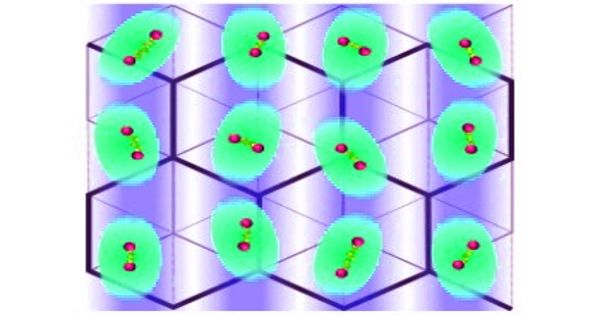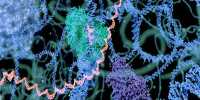At high transition temperatures, researchers discovered a new way to generate 2D superconductivity at an interface of an insulating oxide material.
Interfaces in solids are the foundation of much modern technology. Transistors, which are found in all of our electronic devices, work by controlling electrons at semiconductor interfaces. More broadly, the interface between any two materials can have unique properties that are vastly different from those found in either material alone, paving the way for new discoveries.
Superconducting materials, like semiconductors, have many important implications for technology, from magnets for MRIs to speeding up electrical connections and possibly enabling quantum technology. The vast majority of superconducting materials and devices are 3D, giving them well-understood properties.
The transition temperature – the extremely cold temperature at which a material becomes superconducting – is one of the fundamental questions in superconducting materials. At regular pressures, all superconducting materials become superconducting at temperatures far below the coldest day outside.
New interfacial superconductor has novel properties that raise new fundamental questions and might be useful for quantum information processing or quantum sensing.
Researchers at the United States Department of Energy’s Argonne National Laboratory have discovered a new method for producing 2D superconductivity at a material interface at a relatively high – but still cold – transition temperature. This interfacial superconductor possesses novel properties that raise new fundamental questions and may be useful for quantum information processing or quantum sensing.
Argonne postdoctoral researcher Changjiang Liu and colleagues discovered a novel 2D superconductor at the interface of an oxide insulator called KTaO3 in the study, led by Argonne materials scientist Anand Bhattacharya (KTO). Their findings were published in the journal Science online.
Scientists discovered a thin sheet of conducting electrons between two other oxide insulators, LaAlO3 (LAO) and SrTiO3 (SrTiO3), in 2004. It was later discovered that this material, known as a 2D electron gas (2DEG), can even become superconducting, allowing electricity to be transported without dissipating energy. Importantly, superconductivity could be activated and deactivated using electric fields, just like a transistor.

To achieve such a superconducting state, however, the sample had to be cooled to about 0.2 K – a temperature close to absolute zero (- 273.15 °C), necessitating the use of a specialized apparatus known as a dilution refrigerator. Despite its low transition temperatures (TC), the LAO/STO interface has received a great deal of attention in the fields of superconductivity, spintronics, and magnetism.
The team discovered that interfacial superconductivity could emerge at much higher temperatures in KTO in the new study. To create the superconducting interface, Liu, graduate student Xi Yan, and colleagues grew thin layers of either europium oxide (EuO) or LAO on KTO using Argonne’s cutting-edge thin film growth facilities.
“With this new oxide interface, the application of 2D superconducting devices becomes more feasible,” Liu explained. “This material will not require a dilution refrigerator to be superconducting due to its order-of-magnitude higher transition temperature of 2.2 K. Its one-of-a-kind properties raise a slew of intriguing questions.”
A strange superconductor
Surprisingly, the orientation of the facet of the crystal where the electron gas is formed has a strong influence on this new interfacial superconductivity.
Measurements suggest the formation of stripe-like superconductivity in lower doping samples where rivulets of superconducting regions are separated by normal, nonsuperconducting regions, adding to the mystery. This type of spontaneous stripe formation is also known as nematicity, and it is commonly found in liquid crystal materials used in displays.
“Electronic manifestations of nematicity are uncommon and of great fundamental interest. It turns out that the EuO overlayer is magnetic, and the role of this magnetism in achieving the nematic state in KTO is still unknown “According to Bhattacharya.
The authors also discuss the reasons for the formation of the electron gas in their Science paper. Using atomic resolution transmission electron microscopes, Jianguo Wen of Argonne’s Center for Nanoscale Materials and Professor Jian-Min Zuo’s group at the University of Illinois at Urbana-Champaign demonstrated that defects formed during the overlayer’s growth may play a critical role.
They discovered oxygen vacancies and substitutional defects, in which the potassium atoms are replaced by europium or lanthanum ions, all of which add electrons to the interface and turn it into a 2D conductor. Yan and Argonne scientists Hua Zhou and Dillon Fong used ultrabright X-rays at the Advanced Photon Source (APS) to probe the interfaces of KTO buried beneath the overlayer and observed spectroscopic signatures of these extra electrons near the interface.
“The APS’s interface-sensitive X-ray toolkits enable us to reveal the structural basis for 2DEG formation as well as the unusual crystal-facet dependence of 2D superconductivity. A more in-depth understanding is being developed “Zhou stated.
These findings, in addition to describing the mechanism of 2DEG formation, point the way to improving the quality of the interfacial electron gas by controlling synthesis conditions. Because superconductivity has been observed for both the EuO and LAO oxide overlayers that have been tested thus far, many other possibilities remain to be investigated.













